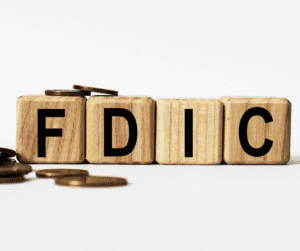How the FDIC helps protect your money
Over the last week we’ve been hearing a lot about disruptions in the banking industry. It began with the failure of Silicon Valley Bank and quickly spread to other regional institutions within a few days. President Biden and Treasury Secretary Janet Yellen attempted to calm the increasingly nervous public by assuring us all that the FDIC has our collective backs.
So what is the FDIC?
The Federal Deposit Insurance Corporation (FDIC) is an independent agency of the U.S. federal government that provides deposit insurance to protect depositors in case an FDIC-insured bank or savings institution fails.
The FDIC was created in 1933 in response to widespread bank failures during the Great Depression. Its primary mission is to maintain stability and public confidence in the nation’s financial system by insuring deposits, examining and supervising financial institutions, and managing receiverships.
FDIC insurance provides depositors with protection of up to $250,000 per depositor, per insured bank, for each account ownership category. This means that if a bank were to fail, the FDIC would step in to pay back depositors up to the insured amount.
FDIC insurance covers deposit accounts at insured banks, including checking, savings, money market deposit accounts, and certificates of deposit (CDs). However, FDIC insurance does not cover the following:
- Investments such as stocks, bonds, mutual funds, and annuities.
- Safe deposit boxes or their contents.
- Losses due to fraud, theft, or embezzlement by bank employees or officers.
- Deposit accounts held in foreign banks.
- Cryptocurrencies such as Bitcoin and Ethereum.
The FDIC provides insurance coverage for both individual accounts and joint accounts, but the rules for each type of account are slightly different.
For individual accounts, each depositor is insured up to $250,000 per insured bank. This means that if you have multiple individual accounts at the same bank, the total balance of all of your individual accounts is insured up to $250,000.
For joint accounts, the FDIC provides insurance coverage up to $250,000 per co-owner for the total amount of all joint accounts held at the same insured bank. This means that if you have a joint account with your spouse, both of you are insured up to $250,000 for that account. If you have multiple joint accounts with different co-owners at the same bank, the total balance of all joint accounts is insured up to $250,000 for each co-owner.
FDIC insurance coverage is good for the life of the deposit, as long as the bank remains insured by the FDIC. The insurance coverage is not based on a time period or the age of the account. If a bank fails, the FDIC will typically try to transfer the deposits to another insured bank or pay depositors their insured funds within a few business days.
What if there’s a run on the bank?
A run on the bank occurs when a large number of depositors try to withdraw their money from a bank at the same time due to concerns about the bank’s solvency. A run on the bank can quickly deplete a bank’s cash reserves and make it unable to meet the demand for withdrawals, leading to the bank’s failure, which is what happened in the recent case of Silicon Valley Bank.
If you are a non-business bank client and are fearful of a run on your bank, there are several things you can do to if you’re concerned about your bank’s solvency.
- Check the FDIC insurance limits: Make sure that your deposits are within the FDIC insurance limits. If you have more than $250,000 in a single account or multiple accounts at the same bank, consider spreading your money across different banks to stay within the insurance limits.
- Keep calm and don’t panic: A run on the bank can be triggered by rumors or speculation as we’ve seen in recent days. Do not withdraw all your money from the bank unless you have a specific need for it.
- Stay informed: Keep up to date with the news about your bank and the broader banking system. The FDIC website provides information about failed banks and the status of the deposit insurance fund.
- Diversify your deposits: Consider diversifying your deposits across different banks and types of accounts. This can help spread your risk and reduce your exposure to a single bank.
- Speak to your bank: If you have concerns about your bank’s stability, speak to a representative at the bank. They can provide you with information about the bank’s financial health and the steps it is taking to ensure the safety of deposits.
Also, it’s important to make sure that your accounts are structured properly to ensure maximum FDIC coverage. You should consult with your bank or give us a call at 262-554-4500 if you have any questions about FDIC insurance coverage for your accounts.






